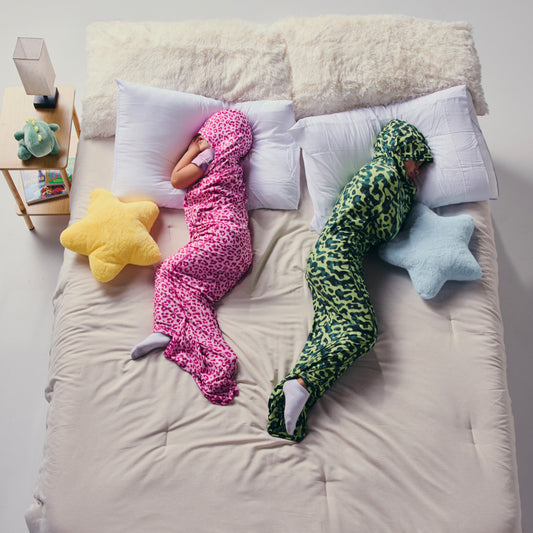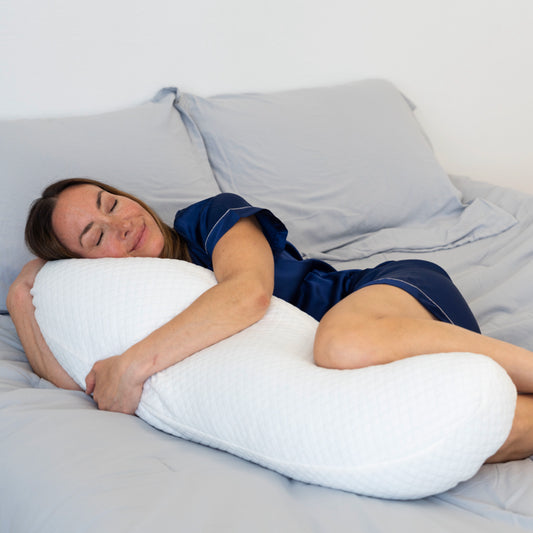Most of us desire better sleep. In an effort to get better sleep, we buy the best mattresses, spend money on fancy pillows, and opt for the most comfortable sheets.
But, have you ever given any thought to the color of lights you’re exposed to at bedtime? Probably not. For many, the color of light they’re exposed to before bed isn’t a concern or even a thought.
However, it turns out that certain colors of light are in fact better than others when it comes to promoting better sleep.
So, before you head to the store for that fancy pillow, let’s take a look at which color light can help you get a better night’s sleep.
Light and the Sleep-Wake Cycle
Before we dive into the topic of color choice, it is important to take some time to examine the role that light has in the body’s natural sleep-wake cycle.
When it comes to external factors that affect sleep, light is the most important factor by far. Think about it for a moment. We sleep better at night for a reason. It isn’t merely a preference that the entire planet coincidentally shares, it’s a biological reality for all humans.
This has to do with light’s role in our body’s internal biological clocks. It essentially signals when it’s time to rise and when it’s time to hit the hay. Light also plays a key role in hormone production, namely melatonin — the sleep hormone.
Light and Circadian Rhythm
Aside from all the neat things our bodies can do, they also come with their own clock. Circadian rhythms are part of the body’s internal clock. These biological mechanisms refer to changes that take place over a 24-hour period. These changes could be mental, physical, or behavioral.
Circadian rhythms help the body carry out important biological functions, such as metabolism, hormone regulation, eating, and sleeping. It is a circadian rhythm known as the sleep-wake cycle that is responsible for regulating wakefulness and sleep, helping us know when it’s time to rise and shine, and when it’s time to call it a night.
It is this sleep-wake cycle that is controlled by environmental factors.
Lights Influence on the Sleep-Wake Cycle
The sleep-wake cycle is directly influenced by light, which acts as an environmental cue. It is in sync with the rotation of light and darkness that takes place in the 24-hour day cycle. The circadian pacemaker of the body is found in the hypothalamus and is known as the suprachiasmatic nuclei (SCN).
Housed within the SCN are light-sensitive neurons. During the day, the exposure of light to our retinal photoreceptors causes the SCN to signal the pineal gland to cease melatonin production. The result is alertness and wakefulness we experience in the mornings and during the day.
On the flip side, once light fades at nighttime, the SCN signals the pineal gland to restart melatonin production once again, inducing sleepiness and getting us ready for bed.
What About Artificial Light?
While the human body comes equipped to follow the 24-hour patterns of night and day when it comes to sleep, artificial light has made a 24/7 daytime possible. This artificial light comes in various forms, from smartphones to street lights to tablets to headlights.
But in terms of the sleep-wake cycle, do these affect us like the light from the sun? Actually, yes, they certainly can, though to a slightly lesser degree. Not all light exposure has the same impact.
For example, direct sunlight emits roughly 32,000 lux (lux being a measurement for illuminance), and that is on the low end.
Here are more examples for comparison:
- Average family living room – 50 lux
- Very overcast day – 100 lux
- Well-lit office with fluorescent lights – 300 to 500 lux
Even at a lower degree, extensive exposure to some artificial lights can still disrupt your circadian rhythm, impacting your sleep patterns and disrupting sleep cycle progression, which could affect your quality of sleep.
Interestingly, the wavelength and color of the light do make a difference.
Color Light and Sleep
It is important to understand that when we talk about the color of light, we are actually talking about a visible spectrum of light wavelengths. We perceive these different wavelengths as colors.
For example, the human eye can see a color range of wavelengths ranging from roughly 400 to 700 nanometers (nm). This range represents the spectral colors known by the acronym ROYGBIV: Red, orange, yellow, green, blue, indigo, and violet.
The wavelengths of these spectral colors are:
- Red: 620 - 750 nm
- Orange: 590 - 620 nm
- Yellow: 570 - 590 nm
- Green: 495 - 570 nm
- Blue: 450 - 495 nm
- Violet: 380 - 450 nm
Violet light/color represents the shortest wavelength and has the highest frequency of energy. Red light has the longest wavelength, as well as the shortest frequency and lowest energy. Indigo has no assigned wavelength.
So, in terms of light color, which is best when it comes to sleep? Let’s take a closer look.
Red Lights and Sleep
The research into which color of light promotes sleep is narrow, but there are some reasons that red might be the best choice when it comes to a light color and sleep. This is partly due to the fact that red light is least likely to disrupt the body’s natural circadian rhythm.
In theory, it is thought that colors close to red on the light spectrum might help stimulate melatonin production. One small study looked at the effects and impact of 30 minutes of nighttime red-light therapy on sleep quality after two weeks.
Researchers found that participants who received the light therapy showed improvement in overall sleep quality and melatonin production as opposed to those that did not receive the treatment.
It is important to remember that studies on these effects are limited at this time. In one sense, the takeaway is the fact that red light shows no negative effect on the sleep-wake cycle, making it okay to use at night — dimly.
The same goes for light of a similar color spectrum, like orange and yellow light (though these should be used less frequently).
Blue Lights and Sleep
While the studies regarding the effectiveness of red light to promote sleep are limited, the research surrounding the effects of blue light and sleep are numerous. Much of this has to do with the brain’s sensitivity towards blue, green, and white lights. These tend to evoke energy and wakefulness more than any other light wavelength.
That is partly because blue light wavelength closely mirrors daytime lights, making it more beneficial during daytime hours. The same benefits it provides during the day, like wakefulness and energy, make it disruptive at night when it comes to sleep.
In short, too much exposure to blue light at nighttime can disrupt the circadian rhythm and sleep-wake cycle, effectively suppressing melatonin production. LED lights are notorious for producing more blue light than incandescent light bulbs.
Put down the electronics at bedtime
If quality sleep is your goal then it may be a good idea to kick electronics out of bed. Blue light waves are produced by fluorescent and LED lights, but they are also produced by back-lit electronics screens.
This includes televisions, tablets, computers, e-readers, video game consoles, and smartphones. Coincidentally, it is these activities that seem to be very popular right before bed — or even in bed.
Some like to binge-watch their favorite show before calling it a night, others can scroll through their social media feeds for hours in bed. Neither bodes well for good, quality sleep.
As hard as the habit might be to break, it is best to put away the electronics before bed. Exposing yourself to blue light for long periods at bedtime is like asking for sleep disruption.
Conclusion
At Hug Sleep, we understand the importance of quality sleep, and light has a big role to play when it comes to sleep.
Our sleep-wake cycle is directly impacted by it, artificial light included.
If you do have a need for some light come bedtime, avoid the blue light, and stick to long-wave colors like red.
For more tips and info on catching some restful zzzs, check our our other blog articles here!
Sources:
Effects of light on human circadian rhythms, sleep and mood | NIH
Light, melatonin and the sleep-wake cycle. | NIH
Linking Light Exposure and Subsequent Sleep: A Field Polysomnography Study in Humans | NIH
What is light? The visible spectrum and beyond | Nature
Red Light and the Sleep Quality and Endurance Performance of Chinese Female Basketball Players | NIH
The Color of the Light Affects the Circadian Rhythms | NIOSH
































400,000+ happy customers